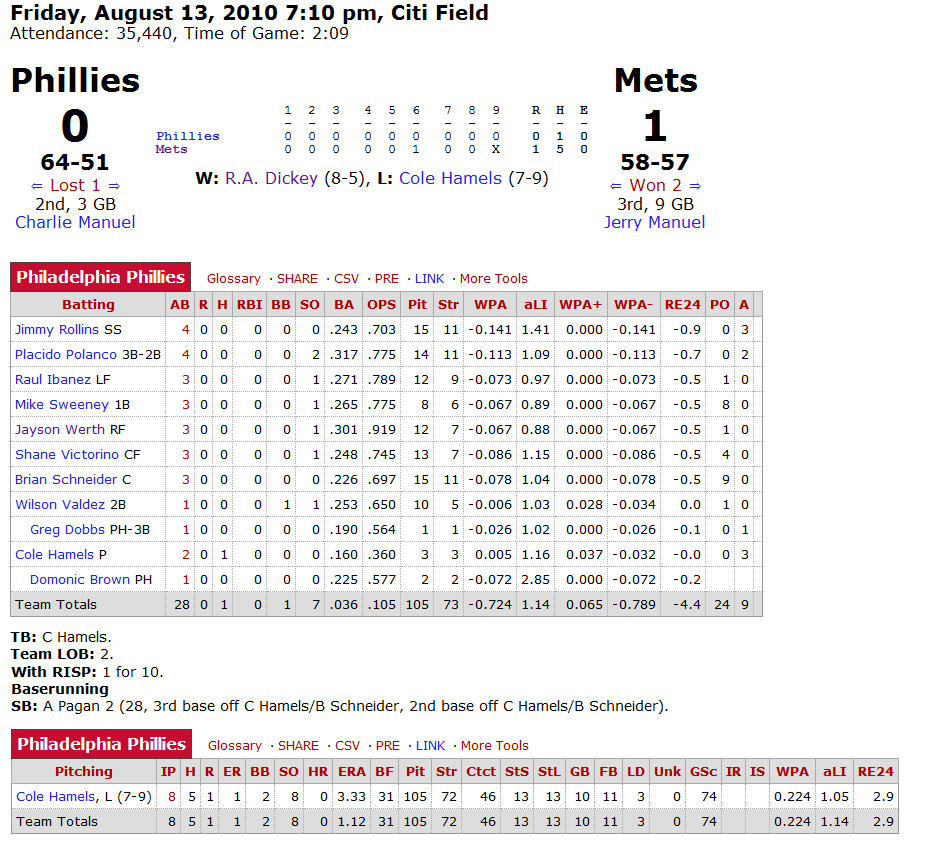The above snippet from an MLB box score is what "Average Joe" sees when he reads the newspaper each morning.
"Ah, yes, I see Pete Rose had another good night."
Perhaps another fan may more closely evaluate this box score and see that Esasky drove in two runs with two QABs, and did not record a single hit. That'a also a good night at the plate.
On the Padres' side of the box, one may notice that Tony Gwynn only had one knock. Surely a sub-par results evening for the greatest contact hitter since, well, Pete Rose. But what did Tony do in his other ABs? Did he hit two missiles right at a fielder? Did he advance any runners because of his advanced approach? Did he get aggressive with a two strike count and a runner on first, knowing that a strikeout would do less harm to his team's chances of scoring than would grounding into a double play? That's important.
The point is, we cannot truly evaluate the game in proper depth with a box score.
As you will see in this game, the first MLB game ever played, the same style of box score was used!
Thank goodness the box score has evolved...a little.
This 2010 box score below is a representation of a shift in our value system. Yes, folks, sabermetrics are taking over the world. Get over it. They're useful, efficient, provide accuracy and depth...and are here to stay.
Now, we can see a player's advanced stats (those that have a higher correlation to success than does batting average or ERA). We also can see how many pitches a player saw in his collective ABs.
This is vital.
Imagine two players with equal stats are free agents. One hitter sees 4.2 pitches per plate appearance (PPA) while the other sees 3.4 PPA. Keep in mind they have nearly identical batting statistics.
Sign the guy who makes the other team work! In order to win big games, most MLB clubs must be able to get to the bullpen as quickly as possible, regardless of the vaunted nature of the opposing club's bullpen. The ability to knock a pitcher out with an aggressive-under-control approach is valuable and has become a highly sought-after skill.
Evaluating a new age box score, we can also see:
1.) How poorly a team or individual does with runners in scoring position.
2.) A pitcher's game score (grading their performance in relationship to a perfect game- score 100)
3.) Defensive statistics
4.) Base running information previously unavailable i.e. which bases were stolen, and off of which pitcher/catcher combo.
But let's focus on the hitting aspect, for the sake of this blog.
When you ask your players, teammates, coaches, friends, son or daughter...
"How did you do?"
How do they typically respond?
"2 for 4."
"0 for 3."
"1 for 5."
What we allow, we encourage. Stop allowing this stupid behavior! This is offensive suicide! We are programming our brains to be focused on and respond with results. Too many hitters are obsessed with their batting average, despite it's extraordinarily low correlation to runs created in comparison with OBP, SLG and hard contact percentage (barrels).
Look, results matter. But in hitting, results are best and most consistently found by focusing on:
1.) The process.
2.) What helps the team win.
Hit the ball hard. Swing at good pitches to hit. Take borderline pitches. Advance runners.
Coaches and parents: measure, reward and celebrate QABs, PPA, OBP, OPS! These measurements are important to value because valuing them creates a mindset of aggressiveness, discipline, and controllables.


No comments
Post a Comment